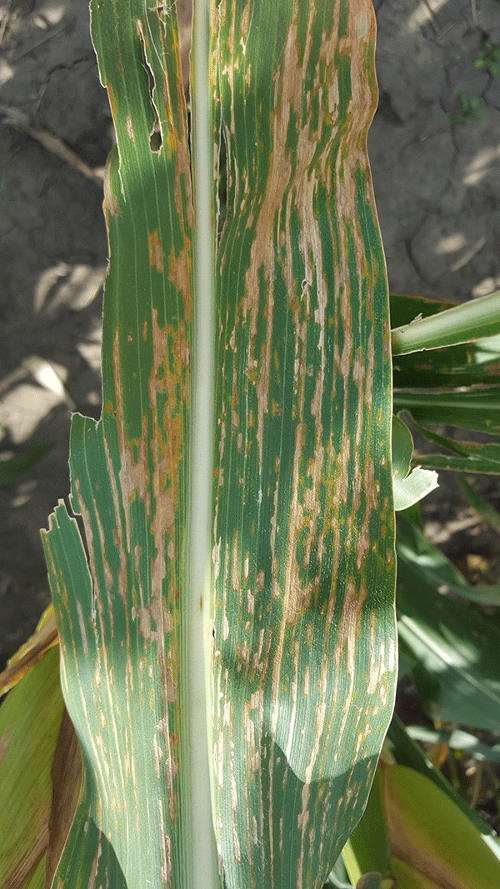By Doug Jardine
On August 26th, the USDA-Animal and Plant Health Inspection Service (APHIS) announced the presence of a new disease in the U.S. corn crop, with the common name bacterial leaf streak disease of corn. A bacteria scientifically known as Xanthomonas vasicola pv. vasculorum (Xvv) is the cause of the disease. APHIS does not consider this plant disease to be of quarantine significance and will treat it as other bacterial diseases of corn such as Goss’s bacterial blight.
Where did it come from and how did it get here?
There are reports that this disease has occurred on corn in South Africa, but it has been most notably associated with gumming disease of sugarcane. It is not currently known how it made its way to the U.S. nor how long it has been here. The disease was first observed in samples submitted to the University of Nebraska-Lincoln Plant and Pest Diagnostic Clinic in 2014. Lack of historical information and the appropriate diagnostic methods delayed its identification until APHIS positively identified the bacteria from a sample collected in Nebraska in August 2016.
Where is it currently found?
Following its initial confirmation, APHIS, working with state departments of agriculture and Extension plant pathologists, initiated a survey of corn fields across the Western Corn Belt. The disease has currently been identified in nine states including Kansas, Nebraska, Colorado, Iowa, Illinois, Minnesota, South Dakota, Texas, and Oklahoma. In Kansas, it has been positively identified in 12 counties, most of which are located in the High Plains. Three additional counties have had corn with symptoms of the disease, but samples have not yet been confirmed definitively by DNA analysis.
What does it look like?
The disease consists of narrow tan to brown streaks on the leaf that can range from less than an inch in length to several inches long (Figure 1). To the untrained eye, the disease can look very similar to the common fungal foliar disease, gray leaf spot.One diagnostic key is that bacterial leaf steak has narrow, wavy-edged lesions compared to gray leaf spot, which has very sharp, straight-edged lesions that follow the veins in the leaf (Figure 2). Sometimes the lesions occur close to the midrib; in other cases, they occur across the leaf blade. A second diagnostic key is that when backlit, light passes through bacterial streak lesions in a translucent manner compared to gray leaf spot, which blocks the light and appears opaque. (Figure 3). Disease symptoms have been observed as early as growth stage V7 with lesions appearing on lower leaves first. Lesions can expand over time to cover larger areas and under favorable conditions, they spread to the upper leaves. In extreme cases, lesions may extend the entire length of the leaf and coalesce to form large, necrotic areas.

Figure 1. Bacterial leaf streak disease in corn. Photo by Tamra Jackson-Ziems, University of Nebraska-Lincoln.
Figure 2. Bacterial streak with wavy-edged lesions (left) and gray leaf spot with straight-edged lesions (right). Photo credit: (left) Tamra Jackson-Ziems, University of Nebraska-Lincoln.
Figure 3. Gray leaf spot lesions are opaque when backlit (left) compared to bacterial streak lesions which are translucent (right).
How does it spread?
It is not currently known how the disease has spread to so many states, but a current hypothesis is that it is seed transmitted. Movement within a field or from field to field may be by the bacteria blowing in the aerosols created by big, blowing thunderstorms. Unlike Goss’s blight, it does not appear that this bacterium needs a wound to aid it in getting into the plant.
Under what conditions is it likely to occur?
By far the single largest scenario associated with the disease is a continuous, no-till, sprinkler irrigated corn production system. This is likely the reason that most counties in Kansas where the disease has been confirmed are in the western part of the state. However, the disease has also been found in furrow irrigated fields, as well as dryland fields in a strict corn-soybean rotation.
Will there be a yield loss and how do I manage the disease?
No research has been conducted to date to determine if there will be any impact on yield. Disease management options are currently limited. Since this is a bacterial disease, fungicides are not effective. Because of the highly erodible nature of most Kansas soils, residue management will not likely be an option except perhaps in southeast Kansas. We do not know how long the bacteria can reside in old crop debris, but observationally, it can survive through the rotational year to soybeans. Observations in hybrid demonstration trials in Nebraska indicate that there are differences in hybrid response to the disease, with some hybrids being much more susceptible than others. Long term, hybrid selection, as with Goss’s blight, will be the primary means of management.